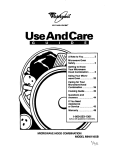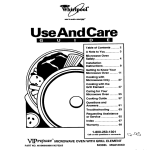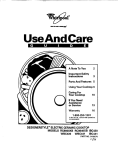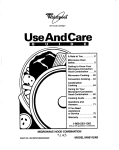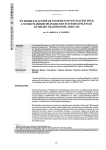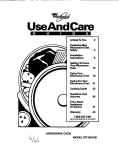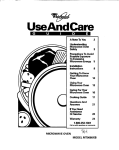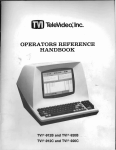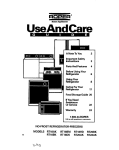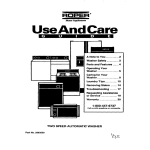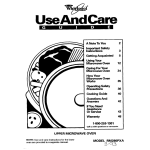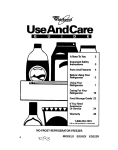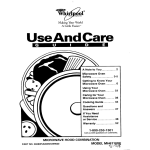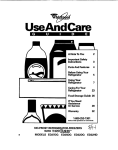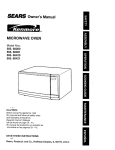Download Whirlpool MH7110XB User's Manual
Transcript
-.wh or H nowlo~*narw~” UseAndCare A Note to You .. ............ .. 2 Microwave Oven Safety .. ......... ......... ......... 3 Getting to Know Your Mlcrowave Hood Combination ...... . 8 Using Your Microwave Oven .... ... ....... .. ... 20 Caring for Your Microwave Hood Combination ................ 46 Cooking Guide . ........... 50 Questions and Answers ........ ............. .. 54 If You Need Assistance or Service ... ....... .......... 55 Warranty ... ......... .......... 60 1-800-253-1301 Call uo with queotiono or CommonIS. MICROWAVE HOOD COMBINATION MODEL MH711OXB A Note to You Thank you for buying a Whirlpool@ appliance. Because your life is getting busier and more complicated, Whirlpool microwave ovens are easy to use, save time, and help you manage your home better. To ensure that you enjoy years of trouble-free operation, we developed this Use and Care Guide. It contains valuable information about how to operate and maintain your microwave oven properly and safely. Please read it carefully. Also, please complete and mail in the Ownership Registration Card provided with your appliance. The card helps us notify you about any new information on your appliance. Your safety is important to us. This guide contains warning symbols and statements. Please pay special attention to this symbol and follow any instructions given. Here is a brief explanation of the use of the warning symbol. This symbol will help alert you to such dangers as personal injury, burns, fire, and electriil shock. Our Consumer Assistance Center is toll-free, 24 hours a day. number, l-800-253-1301, If you ever have a question concerning your appliance’s operation, or if you need service, first see ‘If You Need Assistance or Service” on page 55. If you need further help, feel free to call our Consumer Assistance Center. When calling, you will need to know your appliance’s complete model number and serial number. You can find this information on the model and serial number plate (see diagram on page 10). For your convenience, we have included a handy place below for you to record these numbers, the purchase date from the sales slip, and your dealers name and telephone number. Keep this book and the sales slip together in a safe place for future reference. Model Number Dealer Name Serial Number Dealer Phone Purchare Date Microwave IMPORTANT Oven Safety SAFETY INSTRUCTIONS Microwave ovens have been thoroughly tested for safe and efficient operation. However, as with any appliance, there are special installation and safety precautions which must be followed to ensure safe and satisfactory operation and prevent damage to the unit. To reduce the risk of burns, fire, electrkal shock, injury to persons, exposure to excessive microwave energy, or damage when using the microwave oven, follow basic precautions, including the following: l l l l l l l l l Read all instructions before using the microwave oven. Read and follow the specific “PRECAUTIONS TO AVOID POSSIBLE EXPOSURE TO EXCESSIVE MICROWAVE ENERGY” found on page 5. This appliance must be grounded. Connect only to properly grounded outlet. See “GROUNDING INSTRUCTIONS” found in the Installation Instructions. Install or locate this appliance only in accordance with the provided Installation Instructions. Some products such as whole eggs in the shell and sealed containers - for example, closed glass jars - coti explode and should not be heated in this oven. Do not heat, store, or use flammable materials in or near the oven. Fumes coukl create a fire hazard or explosion. Use this appliance only for its intended use as described in this manual. Do not use corrosive chemicals or vapors in this appliance. This type of oven is specifitally designed to heat or cook food. It is not designed for industrial or laboratory use. As with any appliance, close supervision is necessary when used by children. Do not operate this appliance if it is not working properly, or if it has been damaged. Electrical shock, fire, or l l l l l l l l l other hazards could result. This appliance shouM be serviced only by qualified service personnel. Call an authorized Whirlpool service company for examination, repair, or adjustment. Do not cover or block any opening on the appliance. Fire could result. Do not store this appliance outdoors. Do not use this product near water for example, near a kitchen sink, in a wet basement, or near a swimming pool, and the like. Do not immerse cord or plug in water. Keep cord away from heated surfaces. Do not let cord hang over edge of table or counter. This appliance is suitable for use above both gas and electric cooking equipment 36 inches or less wide. See door surface and interior cleaning instructions on page 46. To reduce the risk of fire in the oven cavity: -Do not overcook food. Carefully attend appliance if paper, plastic, or other combustible materials are placed inside the oven to facilitate cooking. Paper could char or burn, and some plastics could melt if used when heating foods. -Do not deep fry in oven. Microwavable utensils are not suitable and it is difficult to maintain appropriate deep frying temperatures. continued on next page To reduce the risk of fire in the oven cavity (continued): -Test dinnemare or cookware before using. To test a dish for safe use, put it into the oven with a cup of water beside it. Cook at 100% Cook Power for one minute. If the dish gets hot l and water stays cool, do not use it. Borne dishes (melamine, some ceramic dinnennrare, etc.) absorb microwave energy, becoming too hot to handle and slowing cooking times. Cooking in metal containers not designed for microwave use could damage the oven, as co&i containers with hidden metal (twist-ties, foil lining, staples, metallic glaze or trim). - Remove wire twist-ties from paper or plastic bags before placing bag in oven. l -If materials inside the oven should ignite, keep oven door closed, turn oven off, and disconnect the power cord or shut off power at the fuse or circuit breaker panel. 4 l - Do not use the cavity for storage purposes. Do not leave paper products, cooking utensils, or food in the cavity when not in use. Because of the automatic exhaust fan feature, the following cautions must be observed: - Do not leave the area when using your cooktop at a high setting. Accidental fires from boilovers or spattering on the surface unit could spread, especially if the exhaust fan is operating. - Do not allow grease and soil to build up in the grease filter. Exhaust fan efficiency will decrease and fire could result. Clean often following the filter cleaning instructions on page 47. - Do not change the cooktop or oven lights without turning the power off at the main power suppfy (see page 48). Electrical shock could result. - Do not flame foods on a cooktop surface below this unit. The fan, if operating, couM spread the flame and cause personal injury or property damage. Use care when cleaning the vent hood filter. Corrosive cleaning agents, such as lye-based oven cleaners, coukl damage filter. Read and follow “Operating safety precautions” starting on page 6. 1. A short power-supply cord is provided to reduce the risks resulting from becoming entangled in or tripping over a longer cord. 2. Longer cord sets or extension cords are available and may be used if care is exercised in their use. 3. If a long cord or extension cord is used temporarily, (a) the marked electrical rating of the cord set or extension cord should be at least as great as the electriil rating of the appliance, (b) the extension cord must be a grounding- - SAVE THESE type, 3-wire cord that has a 3-blade grounding plug and a 3-slot receptacle that will accept the plug on the appliance, and (c) the longer cord should be arranged so that it will not drape over the countertop or tabletop where it can be pulled on by children or tripped over accidentally. 4. A qualified electrician must install a properly grounded and polarized 3-prong receptacle near the appliance. INSTRUCTIONS - PRECAUTIONS TOAVOID POSSIBLEEXPOSURE TO 1EXCESSIVE MICROWAVE ENERGY... Do not attempt to operate this oven with the door open since open-door operation can result in harmful exposure to microwave energy. It is important not to defeat or tamper with the safety interlocks. Do not place any object between the oven front face and the door or allow soil or cleaner residue to accumulate on sealing surfaces. Do not operate the oven if it is damaged. It is particularly important that the oven door close properly and that there is no damage to the: (1) Door (bent), (2) Hinges and latches (broken or loosened), (3) Door seals and sealing surfaces. Do not operate the microwave oven if the door window is broken. The microwave oven should be checked for microwave leakage by qualified service personnel after a repair is made. The oven should not be adjusted or repaired by anyone except properly qualified service personnel. Do not operate the microwave oven with the outer cabinet removed. 5 Operating safety precautions To reduce the risk of bums, fire, electrical shock, injury to persons, or damage when using the microwave oven, follow the precautions on pages 6-7. Never lean on the door or allow a child to swing on it when the door is open. Injury could result. Never cook or reheat a whole egg inside the shell. Steam buildup in whole eggs may cause them to burst and burn you, and possibly damage the oven. Slice hard-boiled eggs before heating. In rare instances, poached eggs have been known to explode. Cover poached eggs and allow a standing time of one minute before cutting into them. Use hot pads. Microwave energy does not heat containers, but the hot food does. Stir before heating For best results, stir any liquid several times before heating or reheating. Liquids heated in certain containers (especially cylindrical containers) may become overheated. The liquid may splash out with a loud noise during or after heating or when adding ingredients (coffee, etc.) resulting in harm to the oven and possible personal injury. 6 Do not overcook potatoes. Fire could result. At the end of the recommended cooking time, potatoes shoukf be slightly firm because they will continue cooking during standing time. After microwaving, wrap potatoes in foil and set aside for 5 minutes. They will finish cooking while standing. Do not start a microwave oven when it is empty. Product life may be shortened. If you practice programming the oven, put a container of water in the oven. It is normal for the inside of the oven door to look wavy after the oven has been running for a while. Do not try to melt paraffin wax in the oven. Paraffin wax will not melt in a microwave oven because it allows microwaves to pass through it. General information Fuee box Do not use newspaper or other printed paper in the oven. Fire could result. Do not dry flowers, fruit, herbs, wood, paper, gourds, or clothes in the oven. Fire could result. If your electrical power line or outlet voltage is less than 110 volts, cooking times may be longer. Have a qualified electrician check your electrical system. 7 Getting to Know Your Microwave Hood Combination This section discusses the concepts behind microwave cooking and introduces you to the basics you need to know to operate your microwave oven. Please read this information before USe. In This Section Page How mkrowave cooking works ......... 8 Microwave oven features ................. 10 Control panel features ...................... 11 Uslng the exhaust fan ............... ........ 14 How microwave Page Using the cooktoplcountertop light .. 15 Using the hi-level cooking rack ....... 17 Setting the clock ........................ ....... 18 Using the Minute Timer ............... ..... 19 cooking works Magnetron Mkrowave ovens ars safe. Microwave energy ‘E not hot. It causes food to make its own heat, and it’s this heat that cooks the food. Microwaves are like TV waves or light waves. You cannot see them, but you can see what they do. 8 Mixing antenna Oven cevity A magnetron in the microwave oven produces microwaves. The microwaves move into the area under the oven floor. There they bounce off the mixing antenna into the oven where they contact the food. Radio Microwaves pass through most glass, paper, and plastics without heating them so food absorbs the energy. Microwaves bounce off metal pans so food does not absorb the energy. Microwaves may not reach the center of a roast. The heat spreads to the center from the outer, cooked areas just as in regular oven cooking. This is one of the reasons for letting some foods (for example, roasts or baked potatoes) stand for a while after cooking, or for stirring some foods during the cooking time. The microwaves disturb water molecules in the food. As the molecules bounce around bumping into each other, heat is made, like rubbing your hands together. This is the heat that does the cooking. interference Operation of the microwave oven may cause interference to your radio, TV, or similar equipment. When there is interference, it may be reduced or eliminated by taking the following measures: l Clean door and sealing surfaces of the oven. l Adjust the receiving antenna of radio or television. l Move the receiver away from the microwave oven. l Plug the microwave oven into a different outlet so that the microwave oven and receiver are on different branch circuits. Microwave oven features v Your microwave oven is designed to make your cooking experience as enjoyable and productive as possible. To get you up and running quickly, the following is a list of the oven’s basic features: 1. Door Handle. Pull to open door. 2. Door Safety Lock System. The oven will not operate unless the door is securefy Closed. 3. Window with Metal Shield. Shield prevents microwaves from escaping. lt is designed as a screen to allow you to view food as it cooks. 4. Tw*Position Bi-Level Cooking Flack Use for extra space when cooking in more than one container at the same time. See page 17 for more information. 5. Filter. See page 47 for cleaning information. 6. CooktopKountertop Llght. Turn on to light your cooktop or countertop or turn on as a night light. See page 15 for more information. 10 0 6 v 7. Exhaust Fan and Cooktop Light Switches. See pages 14-l 7 for more information. 8. Control Panel. Touch the pads on this panel to perform all functions. paw 1 l-1 3 for more information. See 9. Vent Grille. 10. Cooking Guide. Use as a quick reference for Auto Cook and Auto Defrost settings. 11. Temperature Probe Socket (on oven wall). Plug the Temperature Probe into this socket when using probe for cooking. See page 33 for more information. NOTE: Do not store the Temperature Probe in the oven when probe is not being used. Store in a handy place. 12. Model and Serial Number Plate. Smoke deflector accessory kit A smoke deflector kii for your model is available from your Whirlpool parts dealer to use when installing this microwave oven over cooking products with a grill or griddle. Ask your Whirlpool dealer for details on Kit No. 4353523 - Smoke Deflector Kit. Control panel features Your microwave oven control panel lets you select the desired cooking function quickly and easily. All you have to do is touch the necessary Command Pad. The following is a lii of all the Command and Number Pads located on the control panel. For more information, see oases 14-45. 1. Display. The Display includes a clock and indicators to tell you time of day, cooking time settings, and cooking functions selected. 2. COOK TIME. Touch this pad followed by Number Pads to set a cooking time. See pages 21, 23, and 24 for more information. 3. COOK POWER. Touch this pad followed by a Number Pad to set the amount of microwave energy released to cook the food. The higher the number, the higher the microwave power or “cooking speed.” See page 22 for more information. See the “Microwave cooking chart” on page 51 for specific Cook Powers to use for the foods you are cooking. continued on next page l1 4. ADD MINUTE. Touch this pad to cook for one minute, at 100% Cook Power, or to add an extra minute, at the set Cook Power, to your cooking cycle. See page 44 for more information. 5. AUTO COOK. Touch thii pad to cook common microwave-prepared foods without needing to program times and Cook Powers. See page 25 for more information. 6. AUTO ROAST. Touch this pad to roast with the Temperature Probe. See page 36 for more information. 7. AUTO DEFROST. Touch this pad followed by Number Pads to thaw frozen meat by weight. See page 27 for more information. 8. PERSONAL CHOICE. Touch this pad to recall one cooking instruction previously programmed into memory. See page 40 for more information. 9. PROBE TEMP. Touch this pad when using the Temperature Probe to cook. Touch PROBE TEMP followed by Number Pads to set desired final food temperature. See page 33 for more information. 10. WARM HOLD. Touch this pad to keep hot, cooked foods safely warm in your microwave oven for up to 99 minutes, 99 seconds. WARM HOLD can be used by itself, or it can automatically follow a cooking cycle. See page 32 for more information. 11. BEVERAGE. Touch this pad to reheat one-half cup or one cup of a beverage. The oven will automatically heat for a preset time at a preset Cook Power. See page 41 for more information. 12. POPCORN. Touch this pad when popping popcorn in your microwave oven. The oven will automatically heat for a preset time at a preset Cook Power. See page 43 for more information. 12 13. DINNER PLATE. Touch this pad to 14. 15. 16. 17. 18. 19. 20. 21. 22. 23. 24. reheat a dinner-sized plate of refrigerated food. The oven will automatically heat for a preset time at preset Cook Powers. See page 42 for more information. Number Pads. Touch Number Pads to enter cooking times, Cook Powers, temperatures, quantities, weights, or food categories. CLOCK. Touch this pad to enter the correct time of day. See page 18 for more information. TIMER SET. Touch this pad to set the Minute Timer. See page 19 for more information. TIMER OFF. Touch this pad to cancel the Minute Timer. See page 19 for more information. START/ENTER. Touch this pad to start a function. lf you open the door after the oven begins to cook, retouch START/ ENTER. See page 13 for more information. AUTO START. Touch this pad to program your oven to begin cooking automatically at a chosen time later in the day. See page 38 for more information. OFF/CANCEL. Touch this pad to erase an incorrect command, cancel a program during cooking, or to clear the Display. See page 13 for more information. FAN HIGH. Touch this pad to turn on the fan at high speed. See page 14 for more information. FAN LOW. Touch this pad to turn on the fan at low speed. See page 14 for more information. OFF. Touch this pad to turn off the fan. See page 14 for more information. LIGHT. Touch this pad to turn on the cooktop/countertop light. See page 15 for more information. 25. NIGHT LIGHT. Touch this pad to turn on Interrupting the cooktop/countertop night light. See page 15 for more information. 26. OFF. Touch this pad to turn off the cooktop/countertop light. See page 16 for more information. You can stop the oven during a cycle by opening the door. The oven stops heating and the fan stops, but the light stays on. To restart cooking, close the door and Audible cooking signals Audible signals are available to guide you when setting and using your oven: l A programming tone will sound each time you touch a pad. l One long tone signals the end of a Minute Timer countdown. l Four tones signal the end of a cooking cycle. l Two tones sound once every minute after an End-of-Cooking signal as a reminder if food has not been removed from oven. l Three tones sound if you have made an incorrect entry. To disable audible signals: l Touch and hold Number Pad 1 for four seconds to disable programming tone and End-of-Cooking and End-of-Cycle signals. OR l Touch and hold Number Pad 2 for four seconds to disable all signals. To turn signals back on: Repeat steps under To disable audible signals” above. NOTE: Three tones, followed by two tones, will sound when audible signals are turned on or off. if you do not want to continue cooking: l Close the door and the light goes off. OR Using the demonstration feature You can set your microwave oven to demonstrate its functions without turning the oven on. NOTE: This feature can only be used when the microwave oven is first connected to power. You cannot use the demonstration feature after a Command Pad has been touched. To set the demo feature: 1. Open the door and keep it open. 2. Touch and hold AUTO START for four seconds. Three tones, followed by two tones, will sound. 3. Release AUTO START. 4. Shut the door to start the demo. To cancel the demo feature: Touch OFF/CANCEL. 13 Using the exhaust fan The three pads on the bottom left of the control panel control the 2-speed Exhaust Fan. 1. Choose fan speed. TOUCH NOTE: If the temperature gets too hot around the microwave oven, the exhaust fan in the vent hood will automatically turn on at the LOW setting to protect the oven. It may stay on up to an hour to cool the oven. When this occurs, the Fan OFF Pad will not turn the fan off. OR 2. Turn off fan when desired. To set fan to run for a specific 1. Start fan. time: TOUCH OR 2. Choose timer. YOU SEE NOTE: If both the fan and light are operating and the TIMER Pad is touched twice, both the fan and light will be controlled by the timer. The Display will alternate between “FAN” and “LIGHT one time before 7MF is displayed. twice within 3 seconds 14 3. Set time. Example for 5 minutes: 4. Start timer. TOUCH YOU SEE TOUCH YOU SEE YOU SEE At end of time: To cancel timer: NOTE: Canceling the timer will cause the fan to shut off; however, canceling the fan will not cancel the timer. Using the cooktop/countertop light The three pads on the bottom right of the control panel control the cooktop/countertop light. 1. Choose light. TOUCH I NIGHT LIGHT I 15 2. Turn off light when desired. TOUCH To set light time: to be on for a specific 1. Turn on light. TOUCH OR 2. Choose timer. TOUCH YOU SEE NOTE: If both the fan and light are operating and the TIMER Pad is touched twice, both the fan and light will be controlled by the timer. The Display will alternate between “FAN” and “LIGHT one time before ‘TIME” is displayed. twice within 3 seconds 3. Set time. Example for 20 minutes: 16 TOUCH YOU SEE TOUCH 4. Start timer. YOU SEE At end of time: To cancel YOU SEE TOUCH timer: NOTE: Canceling the timer will cause the light to shut off; however, canceling the light will not cancel the timer. Using the bi-level cooking The Bi-Level Cooking Rack (Part No. 4858524) gives you extra space when cooking in more than one container at the same time. The metal rack can be turned upside-down to help fit taller containers on the bottom of the oven. If you need a replacement rack and your Whirlpool dealer does not stock the rack, you can order it, by part number, by writing to: Whirlpool Corporation Attention: Customer Service Dept. 1900 Whirlpool Drive LaPorte, IN 48350 Inserting Burn Hazard Use hot pads when removing rack from oven after cooking to prevent burns. Rack may be hot. NOTES: l l the rack l l First position l l First position: Insert the rack securely into the rack supports on the side walls of the oven. Second rack l Do not store the metal rack in the oven. Arcing and damage to the oven could resutt if someone accidentally starts the oven. Do not operate the oven with the metal rack stored on the floor of the oven. Damage to the interiir finish will result. Use rack only in the microwave oven. Do not use rack with browning dish. Do not let food container on rack touch the top or sides of the oven. Do not cook foods directly on rack without putting them in containers first. Do not place a metal cooking container on rack. Place a microwave-safe plate under container. position Second position: Turn rack upside-down when using a taller container on the bottom of the oven. 17 Setting the clock When your microwave oven is first plugged in or after a power failure, the Display will show “888:88”. For the first 30 seconds after the power is on, you can set the clock time without touching CLOCK. After 30 seconds has gone by, you must follow the directions below to set the time. If a time of day is not set, “888:88” will show on the Display until you touch CLOCK. NOTES: You can only set the clock if the oven is l l l not cooking food. if you touch in an incorrect time and touch CLOCK, three tones will sound. Enter the correct time. if you touch OFF/CANCEL while setting the clock, the Display will show the last time of day set or “:” if no time of day has been set. To set time: 1. Choose setting. TOUCH YOU SEE TOUCH YOU SEE 2. Enter time of day. Example for 1290: 111 El 3. Complete entry. 18 TOUCH YOU SEE Using the Minute Timer You can use your microwave oven as a minute timer. Use the Minute Timer for timing up to 99 minutes, 99 seconds. NOTE: The oven can operate while the Minute Timer is in use. To see the Minute Timer while the oven is cooking, touch TIMER SET. To return the Display to the cooking time countdown, touch TIMER SET again. 1. Touch TIMER SET. 2. Enter time to be counted down. Example for 1 minute, 30 seconds: If you enter more than 4 digits, three tones will sound. Touch START/ ENTER to count down the 3digit time you have entered or touch OFF/CANCEL to clear the Display. To start over, touch TIMER SET and reenter desired time. TOUCH YOU SEE m I NOTE: ml rm 3. Start countdown. TOUCH If you do not do this step within three seconds of doing Step 2, “START?” will be displayed. You then have one minute to touch START/ENTER or TIMER SET before the Display returns to time of day. NOTE: At end of countdown: A l . m OR YOU SEE (one tone will sound) To cancel Minute During countdown: After countdown: Timer: Using Your Microwave This section gives you instructions carefully. Oven for operating each function. Please read these instructions In This Section Page Getting the best cooking results ..... 20 Cooking at high cook power ............ 21 Cooking at lower cook powers ........ 22 Cooking with more than one cook cycle ... ....................................... 24 Using AUTO COOK ................... ........ 26 Auto cook chart ................................. 26 Using AUTO DEFROST ..................... 27 Auto defrost chart ............................. 29 Defrosting tips ... ................................ 31 Using WARM HOLD .......................... 32 Getting l l Page Cooking with the temperature probe ............................ 33 Using AUTO ROAST ......................... 36 Auto roast chart ................................ 37 Using AUTO START .......................... 36 Using PERSONAL CHOICE .............. 46 Using BEVERAGE ............................. 41 Using DINNER PLATE ...................... 42 Using POPCORN ............................... 43 Using ADD MINUTE .......................... 44 Adding or subtracting cook time.. ...45 the best cooking Although a new rating method’ rates this oven at 850 watts, you may use a reliable cookbook and recipes developed for microwave ovens previousty rated at 700-800 watts. ALWAYS cook food for the minimum recommended cooking time. If necessary, touch ADD MINUTE while the oven is operating or after it has completed the cooking cycle (see page 44 for more information). Then check for doneness to avoid overcooking the food. results l l Stir, turn over, or rearrange food being cooked about halfway through the cook time for most even doneness with all recipes. if a glass cover is not available, use wax paper, paper towels, or microwave-approved plastic wrap. Turn back a corner to vent steam during cooking. l IEC-705 Tbsr Procedure. The IEC-705 Test Procedure Is an lnter~Ilonally recognlzecl method d rdlng mkmwava wdlega output and dms nd mpfesenl an aclud chmnge to oulpul power of caddng puiormanca. 20 Cooking at high cook power 1. Put food in oven and close the door. YOU SEE 2. Set cooking time. Example for 1 minute, 30 seconds: TOUCH III ml ml 3. Start oven. TOUCH YOU SEE At end of cooking time: Changing instructions You can change the cooking time after cooking starts by repeating Step 2. 21 Cooking at lower cook For best results, some recipes call for lower Cook Powers. The lower the Cook Power, the slower the cooking. Each Number Pad also stands for a different percentage of Cook Power. Many microwave cookbook recipes tell you by number, percent, or name which Cook Power to use. COOK POWER NAME HIGH powers The following chart gives the percentage of Cook Power each Number Pad stands for, and the Cook Power name usually used. lt also tells you when to use each Cook Power. WHEN TO USE IT Quick reheating of foods with high water content, such as beverages. If food contains eggs or cream, choose a lower power. Heating large quantities of liquids, such as water or soup stock. Reheating soups or casseroles. 7=70% of full power ‘_ MED-HIGH Cooking requiring special care, such as for high protein sauces, cheese and egg dishes, and casseroles that need to finish cooking. 6=60% of full power 5=50% of full power Cooking and heating vegetables, fish, meat, etc., when you need a Cook Power lower than HIGH or when food is cooking too fast. MED Starting cakes which must be finished on HIGH power or finishing cooking of a large roast. Simmering stews, reheating pastries. MED-LOW, DEFROST Defrosting of foods such as bread, shellfish, and precooked foods. Defrosting and softening butter, cheese, and ice cream. I 1=l 0% of full power LOW Keeping one food serving warm. NOTE: You can also use the Cook Power pad as a second Minute Timer by entering “0” for the Cook Power. The oven will count down the cooking time you set without cooking. 22 1. Put food in oven and close the door. 2. Set cooking time. Example for 7 minutes, 30 seconds: YOU SEE TOUCH El lzl lol 3. Set Cook Power. Example for 50% Cook Power: 4. Start oven. At end of cooking time: Changing TOUCH YOU SEE YOU SEE YOU SEE instructions You can change the cooking time or Cook Power after cooking starts by repeating Steps 2 and/or 3. 23 Cooking with more than one cook cycle For best results, some recipes call for one Cook Power for a certain length of time, and another Cook Power for another length of time. Your oven can be set to change from one to another automatically, for up to two cycles. 1. Put food in oven and close the door. YOU SEE 2. Set cooking tlme for first cycle. TOUCH Example for 7 minutes, 30 seconds: TOUCH 3. Set Cook Power for first cycle. TOUCH YOU SEE TOUCH YOU SEE Example for 50% Cook Power: El 4. Repeat Steps 2 and 3 to set cooking time and Cook Power for the second cycle. 24 5. Start oven. TOUCH YOU SEE (first cycle) After the first cycle is over, the next cycle will count down. At end of cooking time: Changing instructions You can change times or Cook Powers for a cycle any time after that cycle starts by repeating Steps 2 and/or 3. Using AUTO COOK Cooking with AUTO COOK lets you cook common microwave-prepared foods without needing to program times and Cook Powers. AUTO COOK has preset times and Cook Powers for five major food categories: Casseroles, Baked Potatoes, Baked Goods, FreshlCanned Vegetables, and Frozen Vegetables. All you do is touch the Number Pad assigned to the desired category and enter the number of items or servings being heated. Your microwave oven does the rest. NOTE: See “Microwave cooking chart” on page 51 for cooking with Cook Power and cooking time. 1. Put food in oven and close the door. 2. Choose AUTO COOK. 25 3. Choose food category. Touch any of Number Pads l-5. NOTE: See “Auto cook chart” below or the Cooking Guide label on the frame behind the door for food categories available. TOUCH Example for Category 1 (casserole): YOU SEE Then: 4. Enter quantity/servings. Example for 2 servings: TOUCH YOU SEE TOUCH YOU SEE NOTE: If the quantity you entered is not correct, you can change it by touching AUTO COOK again and starting over. 5. Start oven. At end of cooking time: Auto I I cook I CATEGORY 1 I 26 2 3 4 5 chart FOOD Casserole Baked Potatoes Baked Goods Fresh/Canned Vegetables Frozen Vegetables I NUMBER OF SERVINGS/ITEMS YOU CAN COOK I 1-2 1-4 1-2 1-4 l-4 I I Using AUTO DEFROST Your microwave oven automatically defrosts a variety of common meats at preset Cook Powers for preset times, The 2-stage defrost cycle is programmed for meat, poultry, and fish. All you do is touch the Command Pad assigned to the desired category and enter the weight of the items being defrosted. Your microwave oven does the rest. NOTES: See the “Auto defrost chart” on page 29 for defrosting directions for each food. l To defrost items not listed in “Auto defrost chart” on pages 29 and 30, use 30% Cook Power. Refer to a reliable cookbook for defrosting information. l 1. Put frozen food in oven and close the door. 2. Choose AUTO DEFROST. TOUCH YOU SEE mm 3. Choose food category (1 for meat, 2 for poultry, 3 for fish). Example for meat: TOUCH YOU SEE LIl miliHm Then: 4. Enter food’s weight (in pounds and tenths of a pound). Example for 1.2 Ibs: TOUCH YOU SEE NOTES: For converting fractions of a pound to decimals, see ‘Weight conversion chart” on page 31. If you enter an incorrect weight, touch AUTO DEFROST again and enter the correct weight. 27 5. Start oven. 6. After half the cook time is over, Display will prompt you to turn over food. Open door, turn over food, and shield any warm portions. NOTE: If you do not open the door within two minutes, the Display will resume the countdown. 7. Restart oven. At end of defrosting time: 28 Auto Meat defrost chart setting FOOD AT PAUSE SPECIAL INSTRUCTIONS Meat of irregular shape and large, fatty cuts of meat should have the narrow or fatly areas shielded with foil at the beginning of a defrost cycle. B-f Ground Beef, Bulk Remove thawed portions with fork. Turn over. Return remainder to oven. Do not defrost less than l/4 lb. Freeze in doughnut shape. Ground Beef, Patties Separate and rearrange. Do not defrost less than two 4 oz patties. Depress center when freezing. Round Steak Turn over. Cover warm areas with aluminum foil. Place on a microwavable roasting rack. Tenderloin Steak Turn over. Cover warm areas with aluminum foil. Place on a microwavable roasting rack. Stew Beef Remove thawed portions with fork. Separate remainder. Return remainder to oven. Place in a microwavable baking dish. Pot Roast, Chuck Roast Turn over. Cover warm areas with aluminum foil. Turn over. Cover warm areas with aluminum foil. Turn over. Cover warm areas with aluminum foil. Place on a microwavable roasting rack. Remove thawed portions with fork. Return remainder to oven. Separate and rearrange. Place in a microwavable baking dish. chops (% inch thick) Separate and rearrange. Place on a microwavable roasting rack. Hot Dogs Separate and rearrange. Place on a microwavable roasting rack. Spareribs, Country-Style Ribs Turn over. Cover warm areas with aluminum foil. Place on a microwavable roasting rack. Sausage, Links Sausage, Bulk Separate and rearrange. Place on a microwavable roasting rack. Remove thawed portions with fork. Turn over. Return remainder to oven. Turn over. Cover warm areas with aluminum foil. Place in a microwavable baking dish. Rib Roast Rolled Rump Roast Place on a microwavable roasting rack. Place on a microwavable roasting rack. Lamb Cubes for Stew Chops (1 inch thick) Place on a microwavable roasting rack. Pork Loin Roast, Boneless Place on a microwavable roasting rack. 29 Auto defrost chart (continued) Fish setting AT PAUSE SPECIAL INSTRUCTIONS Fillets Turn over. Separate fillets when partially thawed. Place in a microwavable baking dish. Carefully separate fillets under cold water. Steaks Separate and rearrange. Place in a microwavable baking dish. Run cold water over to finish defrosting. Whole Turn over. Place in a microwavable baking dish. Cover head and tail with foil; do not let foi touch sides of microwave oven. Finish defrosting by immersing in cold water. Crabmeat Break apart. Turn over. Place in a microwavable baking dish. Lobster Tails Turn over and rearrange. Place in a microwavable baking dish. Shrimp Separate and rearrange. Place in a microwavable baking dish. Scallops Separate and rearrange. Place in a microwavable baking dish. FOOD Fish Shell Flsh Poultry setting FOOD AT PAUSE SPECIAL INSTRUCTIONS Chicken Whole (up to 9% Ibs) Turn over (finish defrosting breast-side down). Cover warm areas with aluminum foil. Place chicken breast-side up on a microwavable roasting rack. Finish defrosting by immersing in cold water. Remove giblets when chicken is partially defrosted. cut up Separate pieces and rearrange. Place on a microwavable Turn over. Cover warm areas with aluminum foil. Finish defrosting by immersing in cold water. Turn over. Cover warm areas with aluminum foil. Place on a microwavable roasting rack. Finish defrosting by immersing in cold water. Turn over. Cover warm areas with aluminum foil. Place on a microwavable roasting rack. Finish defrosting by immersing in cold water. roasting rack. Comish Hens Whole Turkey Breast (under 6 Ibs) 30 Weight conversion chart You are probably used to food weights as being in pounds and ounces that are fractbns of a pound (for exar@e 4 ounces equals ‘/4 pound). However, in o&r to enter food weight in AUTO DEFROST, you must specify pounds and tenths of a pound. If the weight on the food package is in fractions of a pound, you can use the following chart to convert the weight to decimals. EQUIVALENT OUNCE WEIGHT NUMBER AFTER DECIMAL .lO .20 .25 30 40 SO .60 .70 .75 .80 .90 1.00 - - Defrosting l l l l One-Quarter 1.6 3.2 4.0 4.8 6.4 8.0 9.6 11.2 12.0 12.8 14.4 16.0 Pound One-Half Pound Three-Quarters Pound One Pound tips When uslng AUTO DEFROST, the weight to be entered is the net weight in pounds and tenths of pounds (the weight of the food minus the container). Only use AUTO DEFROST for raw food. AUTO DEFROST gives best results when food to be thawed is a minimum of 0°F. lf food has been stored in a refrigeratorfreezer that does not maintain a temperature of 0°F or below, always program a lower food weight (for a shorter defrosting time) to prevent cooking the food. If the food is kept outslde the freezer for up to 20 minutes, enter a lower food weight. If the fcxxf Is kept outalde the freezer for more than 20 minutes, and for defrosting ready-made food, defrost by time and power and let stand after defrosting. l l l l l The shape of the package alters the defrosting time. Shallow rectangular packets defrost more quickly than a deep block. Separate pieces as they begin to defrost. Separated pieces defrost more easily. You can use small pieces of aluminum foil to shiekf foods like chicken wings, leg tips, and fish tails, but the foil must not touch the side of the oven. Foil can damage the oven lining. Shield areas of food with small pieces of foil if they start to become warm. For better results, a preset standing time is included in the defrosting time. This may make the defrosting time seem longer than expected. (For more information on standing time, see “Microwave cooking tips” on page 52.) 31 Using WARM HOLD You can safely keep hot, cooked food warm in your microwave oven for up to 99 minutes, 99 seconds (about 1 hour, 40 minutes). You can use WARM HOLD by itself, or to automatically follow a cooking cycle. NOTES: WARM HOLD operates for up to 99 l l l l minutes, 99 seconds. Opening the oven door cancels WARM HOLD. Close the door and touch WARM HOLD, then touch START/ENTER if additional WARM HOLD time is desired. Food cooked covered should be covered during WARM HOLD. Pastry Items (pies, turnovers, etc.) should be uncovered during WARM HOLD. l l Complete meals kept warm on a dinner plate should be covered during WARM HOLD. Do not use more than one complete WARM HOLD cycle (about 1 hour, 40 minutes). The quality of some foods will suffer with extended time. 1. Put hot, cooked food in oven and close the door. 2. Choose setting. 3. Start oven. To make l WARM TOUCH HOLD automatically While you are touching In cooking instructions, touch WARM HOLD before follow l OR After the oven starts operating, touch OFF/CANCEL once, touch WARM HOLD, and then touch START/ENTER. 32 another cycle: When the last cooking cycle ls over, you will hear two tones. “WARM ” will come on while the oven continues to run. touching START/ENTER. l YOU SEE l You can set WARM HOLD to follow AUTO DEFROST, COOK, temperature probe cooking, or multi-cycle cooking. Cooking with the temperature The Temperature Probe helps take the guesswork out of cooking roasts and larger casseroles. The probe is designed to turn off the oven when it senses the temperature you chose (between 90°F and 200°F). See your Cookbook for helpful information on cooking different types of food. probe NOTE: If you have not plugged in the Temperature Probe properly or if probe is defective, “PROBE” will appear on the Display, three tones will sound, and the oven will not turn on. After correcting the problem or removing the probe, touch START/ ENTER to clear the Display. 1. Insert probe into food. Insert at least %of the Temperature Probe into the food. (See page 35.) 2. Place food in oven and plug probe into socket on oven wail. Socket Make sure the probe does not touch any part of the oven interior. Plug 3. Close the door. 33 4. Choose setting. TOUCH YOU SEE TOUCH YOU SEE TOUCH YOU SEE NOTE: Food will automatically cook to 160°F if you do not specify a final food temperature. lf you want to specify a final food temperature, do Step 5. Otherwise, skip to Step 6. 5. Set desired final food temperature (optional). Example for 180”: 6. Start oven. When food temperature reaches 90°F: The displayed temperature will change each time food temperature increases by 5°F. If the temperature does not change after 20 minutes, the Display will show “CHECK” and “PROBE”. When food reaches the desired temperature: To change after oven final food temperature has started: 1. Touch PROBE TEMP. You will see the current set temperature. 2. Reenter desired temperature. 3. Touch START/ENTER. NOTE: If you do not touch START/ENTER within one minute after entering the new temperature, the oven will resume heating to the first temperature you set. You can ensure that your new temperature is set by pressing PROBE TEMP (to display the set temperature for three seconds). 34 Temperature tips: l l l l Probe cooking Casseroles cooked using the Temperature l Stir foods during cooking when recommended. Stir soups, casseroles, and drinks before serving. Cover roasts wifh foil after cooking and let stand a few minutes. Remove foil if you decide to cook it longer. Remove the probe from the oven when not cooking by temperature. l l l l l l Probe should be made from precooked foods. Do not use raw meats, raw vegetables, and cream sauces in casseroles. Dry casseroles do not work well. Thaw frozen casseroles and meats in the microwave oven before inserting the probe. If you are cooking more than one individual serving at the same time, such as mugs of soup, check the probe setting in several of the items - all the mugs may not heat at the same rate. Dry meat loaf mixtures do not work well. Check pork and poultry with thermometer in 2-3 places to ensure adequate doneness. Roasts may vary in size, shape, and composition. Use the Temperature Probe as a guide. Don’t: l l For casseroles, the tip of the probe should be in the center of the food. Stir foods when recommended. Replace the Probe. l l l l l l For liquids, balance the probe on a wooden spoon or spatula so the tip of the probe is in the center of the liquid. let probe or probe cable touch any part of the oven interiir. let probe touch foil (ii used). You can keep foil away from probe with wooden tcothpicks. Remove foil if arcing occurs. use paper, plastic wrap, or plastic containers. They will be in the oven too long and might distort. force probe info frozen food. use probe for food that needs to simmer. plug the pointed end of the Temperature Probe info the socket. Removing and cleaning Temperature Probe: the 1. After oven has shut off, unplug the Temperature Probe using an oven mitt or hot pad. 2. Wipe probe with a hot, sudsy cloth and dry thoroughly. Use a plastic scouring pad to remove cooked-on foods. 3. You can place probe in the silverware basket of a dishwasher. l For roasts, the tip of the probe should be in the center of the largest muscle, but not touching fat or bone. 35 Using AUTO ROAST AUTO ROAST lets you roast food with the Temperature Probe: without needing to enter a final food temperature. The probe will turn off the oven when it senses the preprogrammed final food temperature for the food category you chose. 1. Perform Steps 1,2, and 3 under “Cooking with the temperature probe” on page 33. 2. Choose setting. 3. Choose food category. See “Auto roast chart” on page 37 for categories. TOUCH Example for Category 1 (Roast Beef [rare]): 111 4. Start oven. When food temperature TOUCH reaches 90°F: The displayed temperature will change each time food temperature increases by 5°F. If the temperature does not change after 20 minutes, the Display will show “CHECK” and “PROBE”. When food reaches the desired temperature: 36 YOU SEE YOU SEE Auto roast ZATEGORY chart FOOD SPECIAL INSTRUCTIONS 1 Roast Beef (rare) Put tip of probe in center of largest muscle, but not touching fat or bone. Shiekf top of roast with aluminum foil, sauce, or vegetables. Cover roast with foil after cooking and let stand a few minutes. 2 Roast Beef (medium) Put tip of probe in center of largest muscle, but not touching fat or bone. ShieM top of roast with aluminum foil, sauce, or vegetables. Cover roast with foil after cooking and let stand a few minutes. 3 Roast Beef (well) Put tip of probe in center of largest muscle, but not touching fat or bone. Shield top of roast with aluminum foil, sauce, or vegetables. Cover roast with foil after cooking and let stand a few minutes. 4 Roast Pork (well) Put tip of probe in center of largest muscle, but not touching fat or bone. Shield top of roast with aluminum foil, sauce, or vegetables. Cover roast with foil after cooking and let stand a few minutes. 5 Pouttry Shield the wing tips with aluminum foil. Check with thermometer in 2-3 places to ensure adequate doneness. 6 Casserole Make casseroles from precooked foods. Position tip of probe in center of food. Stir before serving. 7 Simmer (liquid) Balance probe on wooden spoon or spatula so tip of probe is in center of liquid. Stir before sewing. NOTE: Food to be roasted must be no less than .l lb and no more than 9.9 Ibs. 37 Using AUTO START AUTO START lets you program your oven to begin cooking automatically at a time of day you choose. You can preprogram your oven up to 11 hours, 59 minutes in advance. NOTES: If you hear the fan start when you touch l l l START/ENTER, you have not set the oven properly. Touch OFF/CANCEL and start over. You cannot use AUTO START with ADD MINUTE, AUTO DEFROST, POPCORN, BEVERAGE, or DINNER PLATE. Do not use foods containing baking powder or yeast when using AUTO START. They will not rise property. To avoid sickness and food waste when using AUTO START: l Do not use foods that will spoil while waiting for cooking to start, such as dishes with milk or eggs, cream soups, and cooked meats or fish. Any food that has to wait for cooking to start should be very cokl or frozen before it is put in the oven. MOST UNFROZEN FOODS SHOULD NEVER STAND MORE THAN TWO HOURS BEFORE COOKING STARTS. l Do not allow focd to remain in oven for more than two hours after end of cooking cycle. 1. Put food in oven and close the door. 2. Make sure clock is set to correct time of day. 38 3. Choose setting. 4. Set start time. Example for 4:30: 5. Enter cooking instructions the function you want. TOUCH YOU SEE TOUCH YOU SEE for (cooking at high power or lower power, temperature probe cooking, AUTO COOK, PERSONAL CHOICE, WARM HOLD) 6. Complete entry. (time of day) The oven will start cooking at the set time. NOTE: If the door is opened before the start time is reached, the Display will show “DO0 R” and “OPEN” for five minutes or until the door is closed, whichever comes first. You must touch START/ENTER to resume AUTO START. At end of cooking time: 39 Using PERSONAL CHOKE PERSONAL CHOICE allows you to recall one cooking instruction previously placed in memory and begin cooking quickly. For example, if you heat a roll every morning, program the cooking steps into PERSONAL CHOICE. You can heat your roll each morning by touching PERSONAL CHOICE. To program PERSONAL PERSONAL CHOICE also allows you to program a function for another person to cook at a later time. NOTE: You can reprogram PERSONAL CHOICE by repeating the instructions below. A power failure will erase your Personal Choice program. CHOICE: 1. Choose PERSONAL CHOICE. TOUCH YOU SEE mm for 4 seconds 2. Set cooking time. TOUCH YOU SEE mm Example for 20 seconds: 3. Set Cook Power. TOUCH YOU SEE TOUCH YOU SEE WpgaA Example for 50% Cook Power: TOUCH El 4. Complete entry. 40 YOU SEE To use PERSONAL CHOICE: 1. Put food in oven and close the door. 2. Choose PERSONAL CHOICE. TOUCH YOU SEE The oven will cook according to your preprogrammed instructions. At end of cooking time: Using BEVERAGE BEVERAGE lets you heat a beverage by touching just one pad. NOTE: If you want to change the heating time after choosing BEVERAGE, see “Adding or subtracting cook time” on page 45. 1. Place cup of beverage in oven and close the door. 2. Choose BEVERAGE. To heat a half cup of a beverage: TOUCH once To heat a full cup of a beverage: TOUCH YOU SEE twice 41 In three seconds, the Display will start counting down. Example for full cup: At end of heating time: Using DINNER PLATE DINNER PLATE lets you reheat a dinnersize plate of refrigerated food. Place meat and bulky vegetables to the outside of the plate. Cover with wax paper. NOTE: If you want to change the heating time after choosing DINNER PLATE, see “Adding or subtracting cook time” on page 45. 1. Place plate of food in oven and close the door. 2. Choose DINNER PLATE. After 3 seconds: At end of first stage, 2 tones will sound. At end of heating time: After one minute: 42 TOUCH YOU SEE Using POPCORN POPCORN lets you pop commercially packaged microwave popcorn by touching just one pad. Pop only one package at a time. lf you are using a microwave popcorn popper, follow manufacturer’s instructions. You can set your microwave oven to pop different size bags of popcorn. You specify the setting by the number of times you touch POPCORN. To correctly set your microwave oven, follow this chart: l l Fire Hazard Do not try to repop unpopped kernels and do not reuse popcorn bags. Fire could result. If you remove the rack right after popping popcorn, use oven mitts. It will be very hot and could bum you. Cooking performance may vary with brand. Try several brands to decide which gives best popping results. For best results, use fresh bags of popcorn. NOTE: If you want to change the popping time after choosing POPCORN, see “Adding or subtracting cook time” on page 45. 1. Place bag In oven and close the door. 2. Choose POPCORN. Example for 3.5 oz regular bags: After 3 seconds, oven starts popping popcorn: (time count8 down) continued on next page 43 YOU SEE Every 10 seconds the Display will alternate between “POP-” and “CORN” and then show the time remaining. (time remaining) At end of popping time: Using ADD MINUTE ADD MINUTE lets you cook food for one minute at 100% Cook Power or add an extra minute to your cooking cycle. You can also use it to extend cooking time in multiples of one minute, up to 99 minutes. l NOTES: l To extend cooking time in multiples of one l l minute, touch ADD MINUTE repeatedly during cooking. You can enter ADD MINUTE only after closing the door, after touching OFF/ CANCEL, or during cooking. 1. Make sure food is in oven. 2. Choose ADD MINUTE. 44 l If you touch ADD MINUTE during cooking, the oven will cook at the currently selected Cook Power. lf you touch ADD MINUTE after cooking is over, the oven will ccok at 100% Cook Power. You cannot use ADD MINUTE with POPCORN, AUTO COOK, or AUTO DEFROST. You cannot use ADD MINUTE to start the oven if any program, other than the Minute Timer, is on the Display. Adding or subtracting cook time If a preset cook time is too long or too short, you can increase or decrease the cook time by 10% after choosing the function. You can only increase or decrease cook time before cooking starts. To increase cook time by 10%: TOUCH YOU SEE (example for auto cook) To decrease cook time by 10%: TOUCH YOU SEE To reset to the original cook time: TOUCH YOU SEE 45 Caring for Your Microwave Hood Combination To make sure your microwave oven looks good and works well for a long time, you should maintain it properly. For proper care, please follow these instructions carefully. NOTE: Abrasive cleansers, steel-wool pads, gritty wash cloths, etc., could damage the control panel, and the interior and exteriir oven surfaces. Use a sponge with a mild detergent or a paper towel with spray glass cleaner. Apply spray glass cleaner to paper towel; do not spray directly on oven. CAE;ning Wipe often with warm, sudsy water and a l sponge or paper towel. l For stubborn soil, boil a cup of water in the oven for 2 or 3 minutes. Steam will soften the soil. To get rid of odors inside the oven, boil a cup of water with lemon juice. Be sure to keep the areas clean where the door and oven frame touch when closed. Use only mild, nonabrasive soaps or detergents applied with a sponge or paper towel when cleaning surfaces. Wipe well with clean water. 46 the bi-level cooking Wash by hand with a miM detergent and a soft or nylon scrub brush. Dry completely. Do not use abrasive scrubbers or cleansers to clean rack. Caring for the filters The grease filters should be removed and cleaned often, at least once a month. NOTE: If your microwave hood combination Rinse well and shake to dry. Do not use ammonia or place in a dishwasher. The aluminum will darken. is installed to recirculate air, the charcoal filter (Part No. 4668792) should be replaced every 6-12 months. The charcoal filter cannot be cleaned. 4. To replace grease filters, slide filter in the frame slot on one side of the opening. Push filter upward and push to the other side to lock into place. 1. For your personal safety, turn off the electrii power at the main power supply. 5. To remove charcoal filter: remove the vent cover mounting screws. 6. Tip the cover forward, then lift out to 2. To remove grease filters, slide each remove. filter to the side. Pull filters downward and push to the other side. The fifter will drop out. 7. Lift the back of the charcoal filter. Slide the filter straight out. 3. Soak grease filters in hot water and a mild detergent. Scrub and swish to remove embedded dirt and grease. continued on next page 47 10. Turn the power back on at the main power supply. 8. Slide a new charcoal filter into place. The filter should rest at the angle shown. 11. Do not operate the hood without the filters in place. 9. Slide the bottom of the vent cover into place. Push the top until it snaps into place. Replace the mounting screws. Replacing the cooktop and oven lights The cooktop light Fire and Electrical Shack Hazard @Use only candelabra-base bulbs, 30watt maximum. Failure to do so couM result in fire. *Turn off power at main power supply before replacing the light bulb. Failure 1 to do so could result in electrical shock. 9i!J?s! 1. Turn off power at the main power supply. 48 I ” 2. Remove the bulb cover mounting screws. 3. We recommend replacing bulb(s) with candelabra-base 30-watt bulb(s) available from your authorized Whirlpool service company (Part No. 4158432) 4. Turn the power back on at the main power supply. The oven 4. Remove bulb holder mounting screw. light 1. Turn off power at the main power supply. 2. Remove the vent cover mounting screws. 3. Tip the cover forward, then lift out to remove. 5. Lift up the bulb holder. 6. We recommend replacing the bulb with a candelabra-base 30-watt bulb available from your authorized Whirlpool service company (Part No. 4156432). 7. Replace the bulb holder and mounting screw. 8. Slide the top of the vent cover into place. Push the bottom until it snaps into place. Replace the mounting screws. Turn the power back on at the main power supply. 49 Cooking Reheating chart Times are approximate and may need to be adjusted to individual taste. STARTINQ TEMP ITEM Meat (Chicken pieces, chops, hamburgers, meat loaf slices) 1 serving 2 servings Meat Slices (Beef, ham, pork, turkey) 1 or more servings Stirrable Casseroles Main Dishes 1 serving 2 servings 4-6 servings Guide TIME/POWER PROCEDURE Cover loosely. Refrigerated Refrigerated l-2 min at 70% 2%-4X min at 70% Room temp 4.5 set-1 min per serving at 50% l-3 min per serving at 50% Refrigerated Cover with gravy orwax paper. Check after 30 set per serving. Cover. Stir after half the time. and Refrigerated Refrigerated Refrigerated 2-4 min at 100% 4-6 min at 100% 6-6 min at 100% Cover with wax paper. Nonstirrable Casseroles and Main Dishes 1 serving 2 servings 4-6 servings Refrigerated Refrigerated Refrigerated 5-8 min at 50% 9-12 min at 50% 13-l 6 min at 50% Soup, Cream 1 cup 1 can (103/r 02) Refrigerated Room temp 3-4% min at 50% 5-7 min at 50% Soup, Clear 1 CJJP 1 can (lOY4 02) Refrigerated Room temp 2X-3% min at 100% 4-5X min at 100% Pizza 1 slice 1 slice 2 slices 2 slices Room temp Refrigerated Room temp Refrigerated 15-25 30-40 30-40 45-55 Vegetables 1 serving 2 servings Refrigerated Refrigerated ?/r-l % min at 100% 1%-2X min at 100% Baked Potato 1 2 Refrigerated Refrigerated l-2 min at 50% 2-3 min at 50% Cut potato lengthwise and then several times crosswise. Cover with wax paper. Room temp Room temp Room temp 6-12 set at 50% 11-15 set at 100% 18-22 set at 100% Wrap single roll, bagel, or muffin in paper towel. TO reheat several, line plate with paper towel. Cover with another paper towel. Refrigerated Refrigerated 5-7 min at 70% 30 set at 100% Breads (Dinner or breakfast 1 roll 2 rolls 4 rolls Pie Whole 1 slice 0 Cover. Stir after half the time. Cover. Stir after half the time. Place on paper towel. set set set set at at at at 100% 100% 100% 100% roll) Cover. Stir after half the time. Microwave cooking chart Times are approximate and may need to be adjusted to individual taste. NOTE: See “Using AUTO COCK” on .page - 25 for cooking without Cook Powers or cooking times. AFOOQ Allow standing time after cooking. FOOD COOK POWER Bacon 100% Ground Beef ror caasoIdes 100% 100% TIME Carrots (1 lb) 8-12 min 45sectol min 15 set par slice Cauliflower 6-9 min 4-6 min Corn on the Cob TIME 1st side 2 min 2nd side 1 l/i to 2Y2 min Hamburger Pattles (4) 100% Meat Loaf 100% 13-19 min 100% 6-9 minllb 1st side 2’h min 2nd side 2-3 min (lE?fbs) Chkken PleceS (medium head) (2) (4) 4-9 min 6-16 min Potatoes, Baked 13-19 min (4 medium) Squash, Summer (1 lb) 3-8 min gT”~p COOK FOOD POWER TlME Applesauce 100% 7-10 min 100% 4-6 min 50% 1-2 min (4 servings) Internal temperature standing. should be 185°F after Turkey Breast 5min 100% -70% 8-12 min/lb internal temperature should be 185°F after ftanding. Fish Fillets 0 FOOD (1 lb) Hamburger Patties (2) w 100% 5-6 min :l lb) Scallops and 100% Shrimp (1 lb) Baked Apples (4) Chocolate (mett 1 =we) Eggs, 100% Scrambled 3X-5Y2 min 1 min 15 sac to 1 min 45sec 2-3 min (2) (4) Zook at 100% Cook Power. ‘OOD TIME Beans, Green or Yellow (1 lb) 6-12 min Broccoli (1 lb) 6-10 min Hot Cereals 100% (1 serving) (4 servings) Nachos 1 S-5 min 4’S7 min 50% 1 Ys-~~Yzmin (large plate) Water for Beverage (1 cup) (2 cups) 100% 2X-4 min 4X-6 min 5’ Microwave Amount cooking tips Covering of food The more food you prepare, the longer it takes. A rule of thumb is that a double amount of food requires almost double the time. If one potato takes four minutes to cook, you need about seven minutes to cook two potatoes. If you want to cook two meals or containers of food at the same time, you can do so with the B-Level Cooking Rack. For example, you can cook two frozen dinners or reheat two plates of food by placing one on the rack and one under the rack. l l Starting temperature Composition l l l Smaller pieces of food will cook faster than larger pieces and same-shaped pieces of food cook more evenly than irregularly shaped foods. With unevenly shaped foods, the thinner parts will cook faster than the thicker areas. Place the thinner parts of chicken wings and legs in the center of the dish. Stirring, l turning foods Stirring and turning foods distributes heat quickly to the center of the dish and avoids overcooking at the outer edges of the food. 52 pressure in foods Several foods (for example: baked potatoes, sausages, egg yolks, and some fruits) are tightly covered by a skin or membrane. This can cause the food to burst from steam building up in them during cooking. To relieve the pressure and to prevent bursting, prick these foods with a fork, cocktail pick, or toothpick. l Using l of food Food with a lot of fat and sugar will be heated faster than food containing a lot of water. Fat and sugar will also reach a higher temperature than water in the cooking process. The more dense the food, the longer it takes to heat. “Very dense” food like meat takes longer to reheat than lighter, more porous food like sponge cakes. Size and shape l Releasing of food The lower the temperature of the food being put into the microwave oven, the longer it takes to cook. Food at room temperature will be reheated more quickly than food at refrigerator temperature. l food Cover food to: l Reduce splattering l Shorten cooking times l Retain food moisture All coverings that allow microwaves to pass through are suitable. l l standing time Always allow food to stand for a while after cooking. Standing time after defrosting, cooking, or reheating always improves Ihe result since the temperature will then be evenly distributed throughout the food. When cooking in a microwave oven, food continues to cook even when the microwave energy is turned off. Food is no longer cooked by microwaves, but it is still being cooked by the high heat left over from the microwave oven. The length of the standing time depends on the volume and density of the food. Sometimes it can be as short as the time it takes you to remove the food from the oven and take it to the serving table. However, with larger, denser food, the standing time may be as long as 10 minutes. Arranging food For best results, distribute food evenly on the plate. You can do this in several ways: If you are cooking several items of the same food, such as baked potatoes, place them in a ring pattern for uniform l cooking. When cocking foods of uneven shapes or thickness, place the smaller or thinner l area of the food towards the center of the dish where it will be heated last. Arrange uneven foods, such as fish, in the oven with the tails to the center. l If you are saving a meal in the refrigerator or “plating” a meal for reheating, arrange the thicker, denser foods to the l outside of the plate and the thinner or less dense foods in the middle. Place thin slices of meat on top of each other or interlace them. Place thkker slices of meat, such as meat loaf and sausages, close to each other. Reheat gravy or sauce in a separate container. l l l When you cock or reheat whole fish, l score the skin - this prevents cracking. Shield the tail and head of whole fish l l with small pieces of foil to prevent overcooking and ensure the foil does not touch the sides of the oven. Do not let food or container touch the top or sides of the oven. This will prevent possible arcing. If you use aluminum containers without package instructions, follow these guidelines: l Place container in a glass bowl and add some water so that it covers the bottom of the container, not more than ‘/4 inch high. This ensures even heating of the container bottom. l Always remove the lid to avoid damage to the oven. l Use only undamaged containers. l Do not usa containers taller than 3%“. l Container must be hatf filled. l To avoid sparking, there must be a minimum l/4” between the aluminum container and the walls of the oven and also between two aluminum containers. l Thickness of the food layer must be greater than thickness of the aluminum. l Reheating food in aluminum foil containers usually takes up to double the time compared to reheating in plastic, glass, china, or paper containers. The time when food is ready will vary a great deal. l Let food stand for 2-3 minutes after heating so that heat is spread evenly throughout container. Cooking you should not do in your microwave oven l l Using aluminum foil Metal containers usually should not be used in a microwave oven. There are, however, some exceptions. lf you have purchased food which is prepackaged in an aluminum foil container, then refer to the instructions on the package. It is possible to use disposable containers, but it generally takes longer and the final result will not be as good as if fcod were placed in plastic or paper containers. Do not do canning of foods in the oven. Closed glass jars may explode, resulting in damage to the oven or possible personal injury. Do not use the microwave oven to sterilize objects (baby bottles, etc.). It is difficult to maintain the high temperature required for safe sterilization. 53 Questions and Answers QUESTIONS ANSWERS Can I use a rack in my microwave oven so that I may reheat or cook on two levels at a time? You can use a rack only if the rack is supplied with your microwave oven. Use of any rack not supplied with the microwave oven can result in poor cooking performance and/or arcing. Can I use either metal or aluminum pans in my microwave oven? Useable metal includes aluminum foil for shielding (use small, flat pieces), small skewers, and shallow foil trays (if tray is ?4 inch deep and filled with food to absotb microwave energy). Never allow metal to touch walls or door. (For more information, see page 53.) Sometimes the door of my microwave oven appears wavy. Is this normal? This appearance is normal and does not affect the operation of your oven. What are the humming noises that I hear when my microwave oven is operating? You hear the sound of the transformer the magnetron tube cycles on. Why does the dish become hot when I microwave food in it? I thought that this should not Mwn. As the food becomes hot it will conduct the heat to the dish. Be prepared to use hot pads to remove food after cooking. What does “standing time” mean? “Standing time” means that food shoukf be taken out of the oven and covered for additional time after cooking. This process allows the cooking to finish, saves energy, and frees the oven for another purpose. Can I pop popcorn in my microwave oven? How do I get the best results? Yes. Pop packaged microwave popcorn following manufacturer’s guidelines or use the preprogrammed Popcorn pad. Do not use regular paper bags. Use the “listening test” by stopping the oven as soon as the popping slows to a “pop” every one or two seconds. Do not try to repop unpopped kernels. You can also use special microwave poppers. When using a popper, be sure to follow manufacturer’s directions. Do not pop popcorn in glass utensils. Why does steam come out of the air exhaust vent? Steam is normally produced during cooking. The microwave oven has been designed to vent this steam out the top vent. wher If You Need Assistance or Service This section is designed to help you save the cost of a service call. Part 1 of this section outlines possible problems, their causes, and actions you can take to solve each problem. Parts 2 and 3 tell you what to do if you still need assistance or service. When calling our Consumer Assistance Center for helo or callina for service, please provide a detailed description of the problem, your appliance’s’complete;nodel and serial numbers, and the purchase date. (See page 2.) This information will help us respond properly to your request. 1. Before calling for assistance ... Perfomnce problems often result from little things you can find and fix without tools of any kind. Please check the chart below for problems you can fix. It could save you the cost of a service call. PROBLEM Nothing will operate The microwave oven will not run SOLUTION POSSIBLE CAUSE The unit is not wired into a live circuit with the proper voltage. Contact a qualified Whirlpool service technician to wire unit into a live circuit with the proper voltage. (See Installation Instructions.) A household fuse has blown or a circuit breaker has tripped. Replace household fuse or reset circuit breaker. The electric company has experienced a power failure. Check electrii failure. You are using the oven as a timer. Touch TIMER OFF to cancel the Minute Timer. If you are using the Temperature Probe, probe is not plugged tightly into its socket. Plug Temperature its socket. The door is not firmly closed and latched. Firmly close and latch door. You did not touch START/ ENTER. Touch START/ENTER. You did not follow directions exactly. Check instructions you are operating. An operation that was programmed earlier is still running. Touch OFF/CANCEL to cancel previous programming. company for a power Probe tightly into for the function continued on next page 55 PROBLEM POSSIBLE CAUSE SOLUTION The electric supply to your home or wall outlets is low or lower than normal. Your electric company can tell you if the line voltage is low. Your electrician or service technician can tell you if the outlet voltage is low. The Cook Power is not at the recommended setting. Check “Microwave page 51. There is not enough cooking time for the amount of food being cooked. Allow for more time when cooking mOre food at one time. The Display shows a time counting down but the oven is not cooking The oven door is not closed completely. Completely close oven door. You have set the controls as a Minute Timer. Touch TIMER OFF to cancel the Minute Timer. You do not hear the Programming Tone The command is not correct. Reenter command. The microwave oven turns off too soon or not soonenough when using the Temperature Probe Probe is not pushed far enough into the food. Insert at least l/3 of probe into the food. Probe is not positioned correctly in the food. Position probe tip in the center of the food. When cooking roasts, you have not let roast stand after cooking. Allow roast to sland for a few minutes after cooking. Probe is not plugged in correctly. Plug probe tightly into its socket. Cook Power is not set correctly. Reset the Cook Power. Probe temperature correctly. Reset the probe temperature. Microwave cooking times seem too long The Display shows “888:88” 56 is not set There has been a power interruption. Reset the clock. cooking chart” on 2. If you need assistance ... Call Whirlpool Consumer Assistance Center telephone number. Dial toll-free from anywhere in the U.S.A.: 1-800-253-l -.9 l 301 and talk with one of our trained consultants. The consultant can instruct you in how to obtain satisfactory operation from your appliance or, if service is necessary, recommend a qualified service company in your area. If you prefer, write to: Mr. William Clark Consumer Assistance Representative Whirlpool Corporation 2000 North M-63 Benton Harbor, Ml 49022-2692 Please include a daytime phone number in your correspondence. 3. If you need 4. If you are not satisfied with how the problem was solved . . . service l l Contact the Major Appliance Consumer Action Panel (MACAP). MACAP is a group of independent consumer experts that voices consumer views at the highest levels of the major appliance industry. Contact MACAP only when the dealer, authorized servicer, and Whirlpool have failed to resolve your problem. Major Appliance Consumer Action Panel 20 North Wacker Drive Chicago, IL 60606 MACAP will in turn inform us of your action ... Whirlpool has a nationor wide network of authoSERVICErized Whirlpool service companies. Whirlpool service technicians are trained to fulfill the product warranty and provide after-warranty service, anywhere in the United States. To locate the authorized Whirlpool service company in your area, call our Consumer Assistance Center telephone number (see Step 2) or look in your telephone directory Yellow Pages under: .APPLlANCE-HOUSEHOLDYAIOR. SERVlCE A REPAIR - Sea: Whirlpeal Appliances or Authorized Whirlpool Service (Exam@e:XYZ Scwce Co.) .WASHING MACHINES 6 DRYERS, SERVICE 6 REPAJR See: Wh+-aol Appliances or Aullwrized Whirlpool Serwce (ExsmpkcXYZ Servre Co.) 57 WHIRLPOOL” Microwave Oven Warranty LENGTH OF WARRANTY FULL ONE-YEAR WARRANTY From Date of Purchase LIMITED FOUR-YEAR WARRANTY Second Through Fifth Year From Date of Purchase WHIRLPOOL 1 WHIRLPOOL WILL PAY FOR FSP@ replacement parts and repair labor to correct defects in materials or workmanship. Service must be provided by an authorized Whirlpool service company. FSP replacement magnetron tube on microwave ovens if defective in materials or workmanship. WILL NOT PAY FOR A. Service calls to: 1. Correct the installation of your microwave oven. 2. Instruct you how to use your microwave oven. 3. Replace house fuses or correct house wiring. 4. Replace owner-accessible light bulbs. B. Repairs when your microwave oven is used in other than normal, single-family household use. C. Pickup and delivery. Your microwave oven is designed to be repaired in the home. D. Damage to your microwave oven caused by accident, misuse, fire, flood, acts of God, or use of products not approved by Whirlpool. E. Any labor costs during limited warranty. F. Repairs to parts or systems caused by unauthorized modifications made to the appliance. YEI3 WHIRLPOOL CORPORATION SHALL NOT BE LIABLE FOR INCIDENTAL OR CONSEQUENTIAL DAMAGES. Some states do not allow the exclusion or limitation of incidental or consequential damages, so this limitation or exclusion may not apply to you. This warranty gives you specific legal rights, and you may also have other rights which vary from state to state. Outside the United States, a different warranty may apply. For details, please contact your authorized Whirlpool distributor or military exchange. If you need service, first see the “If You Need Assistance or Service” section of this book. After checking “If You Need Assistance or Service,” additional help can be found by calling our Consumer Assistance Center telephone number, l-800-253-1 301, from anywhere in the U.S.A. PART NO. 3874WROO/4358513 Q 1905 Whirlpool Corporation Rev. A @Registered Trademark of Whirlpool, U.S.A. Pmied in Korea


























































